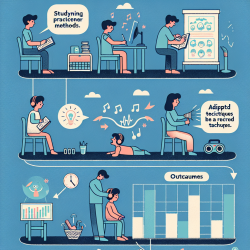Introduction
In the rapidly evolving field of speech-language pathology, understanding the intricacies of brain function is paramount to developing effective therapeutic strategies. A recent study titled "Brain Information Processing Capacity Modeling" offers groundbreaking insights into how the brain's information processing capacity can influence cognitive tasks and outcomes, particularly in children. This blog explores the implications of this research for practitioners and highlights the potential for improving child development outcomes through data-driven approaches.
The Science Behind Information Processing Capacity
The study introduces a mathematical model that quantifies the information processing capacity of brain regions in terms of neuronal activity, input storage capacity, and the arrival rate of afferent information. This model was applied to fMRI data from a flanker paradigm, revealing that higher information processing capacity correlates with lower neuronal activity and faster cognitive responses. This finding is crucial for understanding age-related differences in cognitive performance and offers a predictive framework for assessing brain dynamics.
Implications for Child Development
Understanding the brain's information processing capacity can significantly impact child development strategies. Here are some key takeaways for practitioners:
- Enhanced Cognitive Assessments: By evaluating a child's information processing capacity, practitioners can tailor cognitive assessments to better understand individual strengths and weaknesses.
- Targeted Interventions: Data-driven insights can inform targeted interventions that enhance cognitive efficiency, potentially leading to improved educational and therapeutic outcomes.
- Predictive Modeling: The model's predictive validity allows practitioners to anticipate developmental trajectories and adjust interventions accordingly.
Encouraging Further Research
The study underscores the importance of further research into the brain's information processing capacity, particularly in the context of child development. Practitioners are encouraged to explore the following areas:
- Longitudinal Studies: Conducting longitudinal studies to track changes in information processing capacity over time and its impact on developmental milestones.
- Cross-Disciplinary Collaboration: Collaborating with neuroscientists and psychologists to integrate findings into holistic child development programs.
- Technological Integration: Leveraging advanced imaging techniques and data analytics to refine models and enhance predictive accuracy.
Conclusion
The research on brain information processing capacity offers a promising avenue for enhancing child development outcomes. By integrating these insights into practice, speech-language pathologists can make more informed, data-driven decisions that support children's cognitive growth. As we continue to unravel the complexities of the brain, the potential for transformative impacts on child development becomes increasingly evident.
To read the original research paper, please follow this link: Brain information processing capacity modeling.










